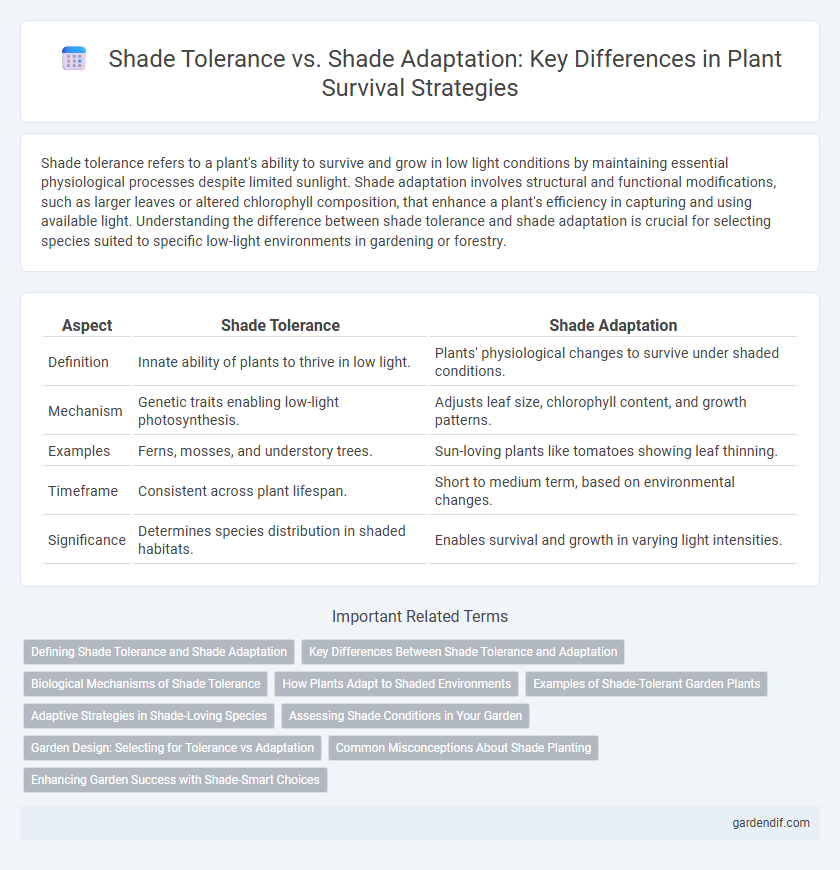
Shade Tolerance vs Shade Adaptation Illustration
Shade tolerance refers to a plant's ability to survive and grow in low light conditions by maintaining essential physiological processes despite limited sunlight. Shade adaptation involves structural and functional modifications, such as larger leaves or altered chlorophyll composition, that enhance a plant's efficiency in capturing and using available light. Understanding the difference between shade tolerance and shade adaptation is crucial for selecting species suited to specific low-light environments in gardening or forestry.
Table of Comparison
| Aspect | Shade Tolerance | Shade Adaptation |
|---|---|---|
| Definition | Innate ability of plants to thrive in low light. | Plants' physiological changes to survive under shaded conditions. |
| Mechanism | Genetic traits enabling low-light photosynthesis. | Adjusts leaf size, chlorophyll content, and growth patterns. |
| Examples | Ferns, mosses, and understory trees. | Sun-loving plants like tomatoes showing leaf thinning. |
| Timeframe | Consistent across plant lifespan. | Short to medium term, based on environmental changes. |
| Significance | Determines species distribution in shaded habitats. | Enables survival and growth in varying light intensities. |
Defining Shade Tolerance and Shade Adaptation
Shade tolerance refers to a plant's inherent ability to survive and grow in low-light environments without significant stress or damage. Shade adaptation involves physiological and morphological changes that enable a plant to adjust and optimize its growth in shaded conditions over time. Understanding these concepts is essential for selecting appropriate species for shaded landscapes or forest understories.
Key Differences Between Shade Tolerance and Adaptation
Shade tolerance describes a plant's inherent ability to survive and photosynthesize under low light conditions without significant stress, relying on structural leaf traits and efficient chlorophyll use. Shade adaptation involves physiological and morphological changes over time, enabling plants to adjust to shaded environments by modifying growth patterns, leaf size, or chloroplast function. Key differences include tolerance being a fixed trait for survival in shade, whereas adaptation is a dynamic process allowing plants to optimize performance in varying light intensities.
Biological Mechanisms of Shade Tolerance
Shade tolerance involves complex biological mechanisms such as altered chlorophyll composition, increased chloroplast efficiency, and enhanced light-harvesting complexes that maximize photosynthesis under low-light conditions. Plants exhibiting shade tolerance often show morphological changes like thinner leaves with larger surface areas to capture diffuse light more effectively. These adaptations optimize energy use and growth in habitats with limited sunlight compared to shade adaptation that might involve behavioral or structural changes without deep metabolic or physiological shifts.
How Plants Adapt to Shaded Environments
Plants adapt to shaded environments through shade tolerance and shade adaptation mechanisms that optimize light capture and photosynthesis. Shade-tolerant species exhibit physiological traits such as larger chloroplasts and increased chlorophyll content to maximize low-light absorption, while shade-adapted plants modify their leaf morphology, including larger, thinner leaves, to enhance light interception. These adaptations enable plants to maintain growth and energy production despite limited sunlight in densely vegetated or forest understories.
Examples of Shade-Tolerant Garden Plants
Shade tolerance in garden plants refers to their ability to survive and grow under low light conditions without significant stress, while shade adaptation involves specific physiological changes that allow plants to optimize light absorption in shaded environments. Examples of shade-tolerant garden plants include hostas, ferns, and astilbes, which thrive in understory conditions with minimal direct sunlight. These species exhibit broad, dark green leaves to maximize photosynthesis and maintain healthy growth in shaded landscapes.
Adaptive Strategies in Shade-Loving Species
Shade tolerance in plants involves physiological and morphological traits that allow survival under low light by efficiently using limited sunlight, whereas shade adaptation encompasses broader evolutionary strategies, including altering leaf structure and chlorophyll concentration to optimize photosynthesis in shaded environments. Shade-loving species exhibit adaptive strategies such as increased chlorophyll b content to capture light more effectively and elongated petioles to reach light gaps. These adaptations enhance carbon fixation and energy use efficiency, enabling sustained growth in understory habitats with minimal sunlight.
Assessing Shade Conditions in Your Garden
Assessing shade conditions in your garden involves measuring light intensity, duration, and quality under tree canopies or structures to determine the level of shade tolerance or adaptation required for plants. Use tools like a light meter or observe sun patterns throughout the day to accurately identify areas of full shade, partial shade, or dappled sunlight. Understanding these shade characteristics helps select species that thrive under specific light conditions, improving plant health and garden productivity.
Garden Design: Selecting for Tolerance vs Adaptation
Shade tolerance refers to a plant's ability to survive and grow in low-light conditions without significant stress, making shade-tolerant species ideal for garden areas with consistent, dense shade. Shade adaptation involves physiological and morphological changes that allow plants to optimize light capture and photosynthesis, which can be advantageous in gardens with variable or dappled shade patterns. Selecting plants based on tolerance ensures stability in heavily shaded spots, while choosing species adapted to shade supports dynamic growth in gardens with fluctuating light levels.
Common Misconceptions About Shade Planting
Many gardeners confuse shade tolerance with shade adaptation, assuming plants labeled as shade-tolerant will thrive in deep, dense shade. Shade tolerance means a plant can survive with limited light but not necessarily flourish, whereas shade adaptation involves physiological adjustments allowing growth in low-light environments. Misunderstanding these differences often leads to poor plant selection and unsatisfactory garden performance.
Enhancing Garden Success with Shade-Smart Choices
Shade tolerance refers to a plant's inherent ability to survive and grow in low-light conditions, while shade adaptation involves the modifications a plant undergoes to improve its performance in shaded environments. Selecting shade-tolerant species like hostas, ferns, or astilbes ensures foundational success, whereas understanding shade adaptation mechanisms, such as leaf morphology changes, can guide effective garden management. Employing shade-smart choices maximizes photosynthesis efficiency and promotes vigorous growth, enhancing overall garden vitality in shaded areas.
Shade Tolerance vs Shade Adaptation Infographic

 gardendif.com
gardendif.com